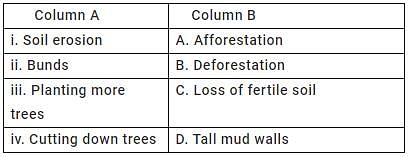Class 5 Exam > Class 5 Tests > Online MCQ Tests for Class 5 > Test: Soil, Rocks & Minerals - 1 - Class 5 MCQ
Test: Soil, Rocks & Minerals - 1 - Class 5 MCQ
Test Description
10 Questions MCQ Test Online MCQ Tests for Class 5 - Test: Soil, Rocks & Minerals - 1
Test: Soil, Rocks & Minerals - 1 for Class 5 2024 is part of Online MCQ Tests for Class 5 preparation. The Test: Soil, Rocks & Minerals - 1 questions and answers have been
prepared according to the Class 5 exam syllabus.The Test: Soil, Rocks & Minerals - 1 MCQs are made for Class 5 2024 Exam. Find important
definitions, questions, notes, meanings, examples, exercises, MCQs and online tests for Test: Soil, Rocks & Minerals - 1 below.
Solutions of Test: Soil, Rocks & Minerals - 1 questions in English are available as part of our Online MCQ Tests for Class 5 for Class 5 & Test: Soil, Rocks & Minerals - 1 solutions in
Hindi for Online MCQ Tests for Class 5 course. Download more important topics, notes, lectures and mock
test series for Class 5 Exam by signing up for free. Attempt Test: Soil, Rocks & Minerals - 1 | 10 questions in 10 minutes | Mock test for Class 5 preparation | Free important questions MCQ to study Online MCQ Tests for Class 5 for Class 5 Exam | Download free PDF with solutions
Test: Soil, Rocks & Minerals - 1 - Question 1
Which among the following factors is not responsible for soil erosion?
Detailed Solution for Test: Soil, Rocks & Minerals - 1 - Question 1
Test: Soil, Rocks & Minerals - 1 - Question 2
Which of the following is responsible for the continuous heating and cooling of rocks that finally forms soil?
Detailed Solution for Test: Soil, Rocks & Minerals - 1 - Question 2
| 1 Crore+ students have signed up on EduRev. Have you? Download the App |
Test: Soil, Rocks & Minerals - 1 - Question 3
Tall mud walls built on the sides of the rivers, to conserve soil are called:
Detailed Solution for Test: Soil, Rocks & Minerals - 1 - Question 3
Detailed Solution for Test: Soil, Rocks & Minerals - 1 - Question 4
Detailed Solution for Test: Soil, Rocks & Minerals - 1 - Question 6
Detailed Solution for Test: Soil, Rocks & Minerals - 1 - Question 7
Test: Soil, Rocks & Minerals - 1 - Question 8
Which among the following is an example of metamorphic rock?
Detailed Solution for Test: Soil, Rocks & Minerals - 1 - Question 8
Test: Soil, Rocks & Minerals - 1 - Question 9
About 95% of earth?s crust is made up of which rocks?
Detailed Solution for Test: Soil, Rocks & Minerals - 1 - Question 9
Detailed Solution for Test: Soil, Rocks & Minerals - 1 - Question 10
|
243 tests
|
Information about Test: Soil, Rocks & Minerals - 1 Page
In this test you can find the Exam questions for Test: Soil, Rocks & Minerals - 1 solved & explained in the simplest way possible.
Besides giving Questions and answers for Test: Soil, Rocks & Minerals - 1, EduRev gives you an ample number of Online tests for practice


















